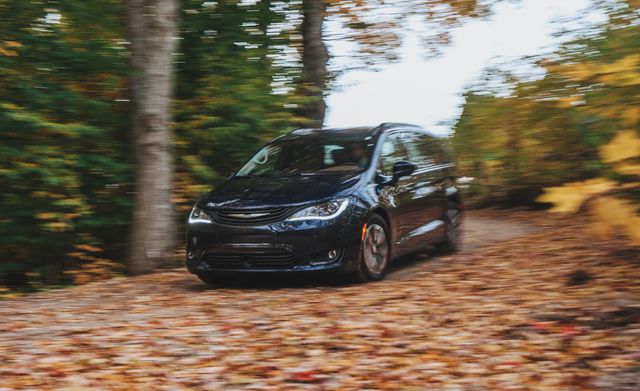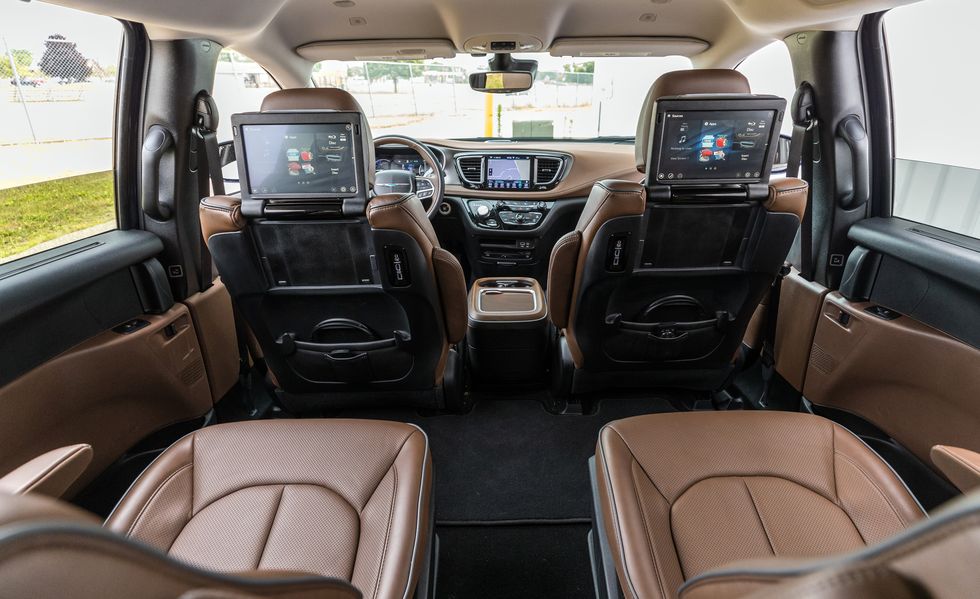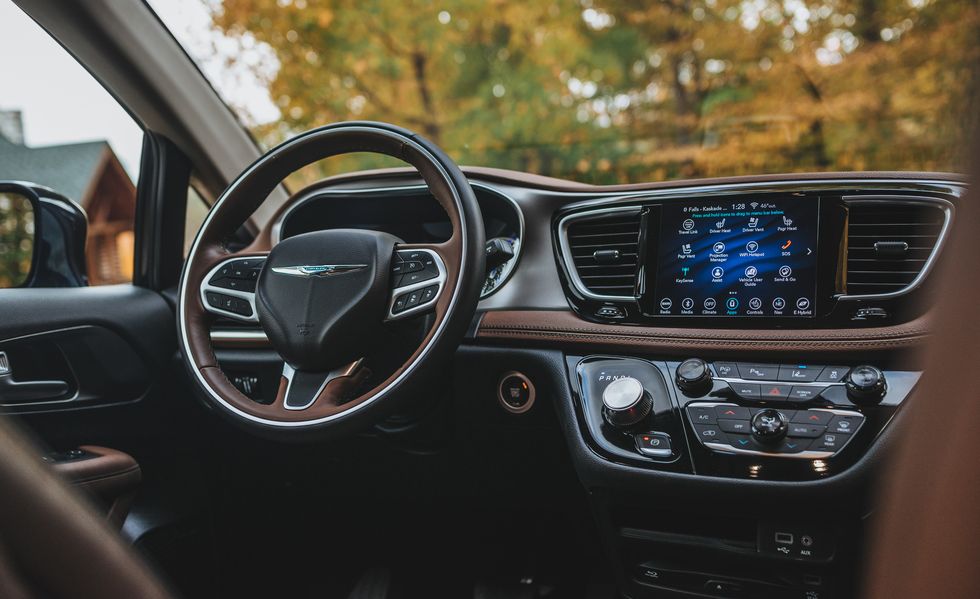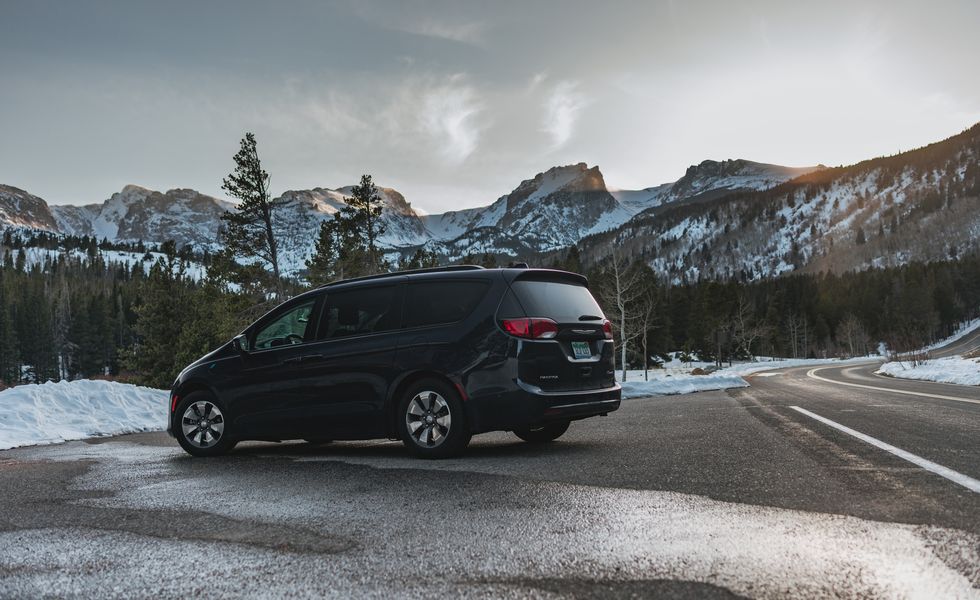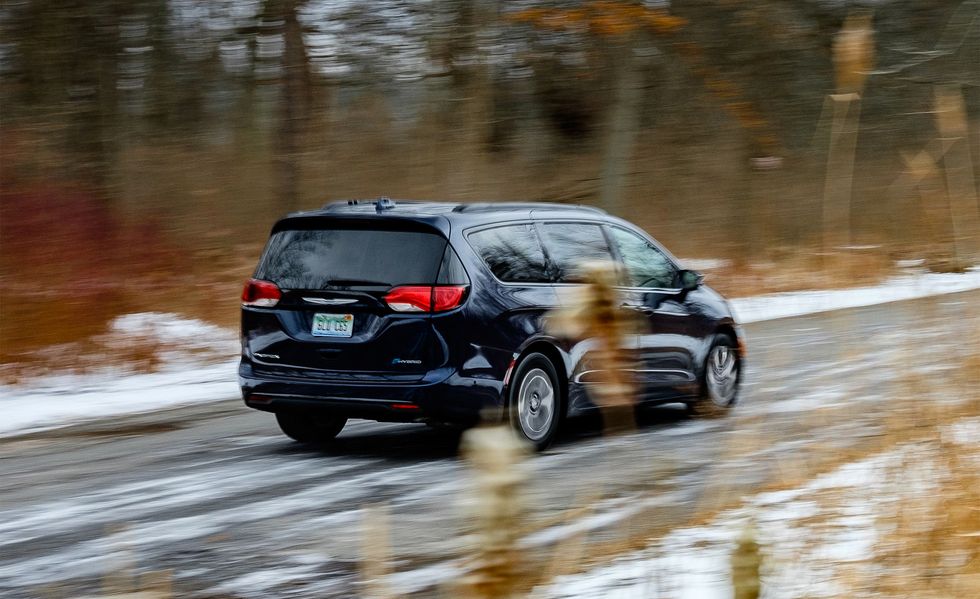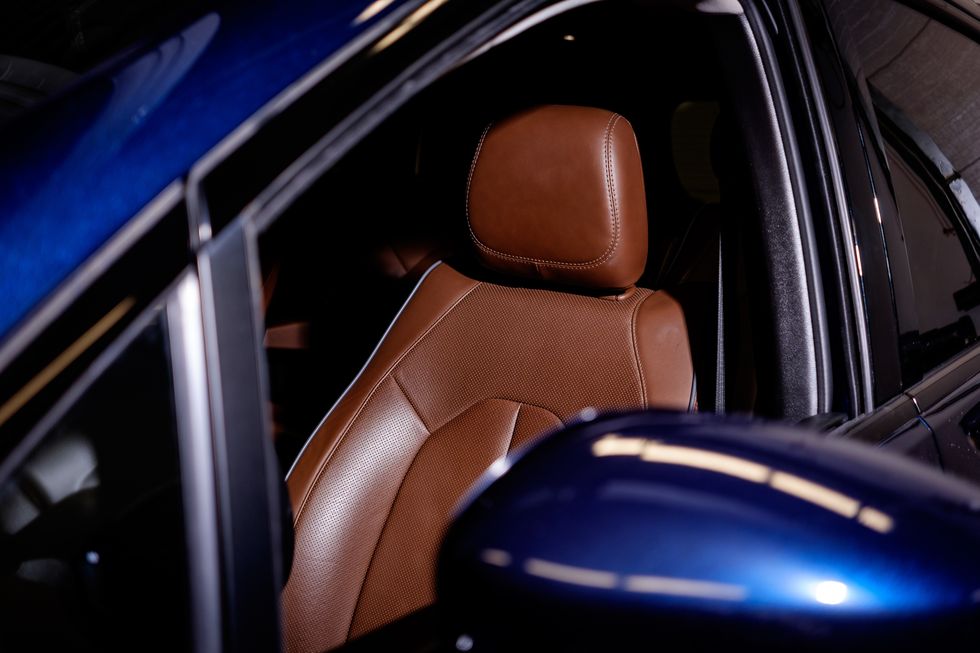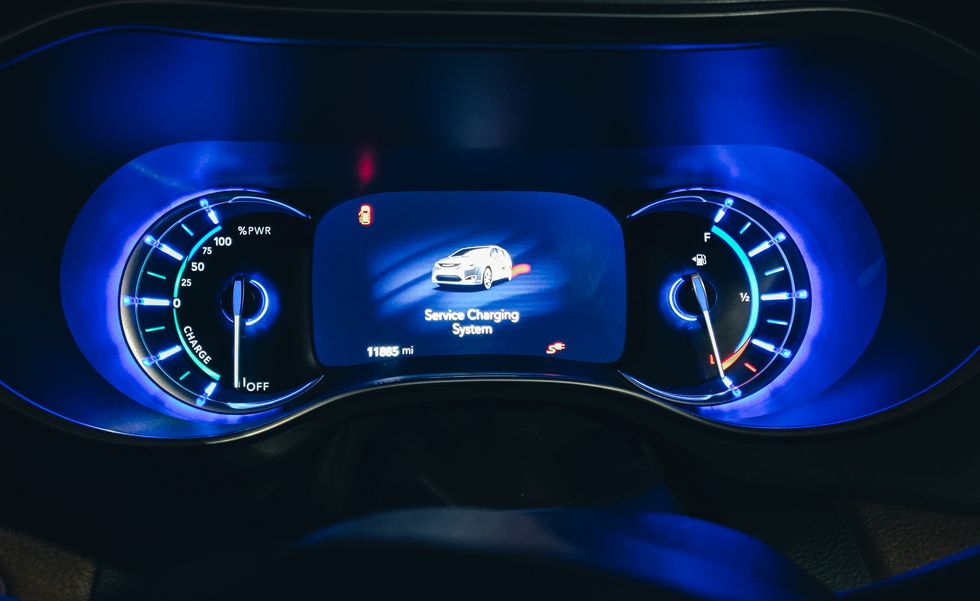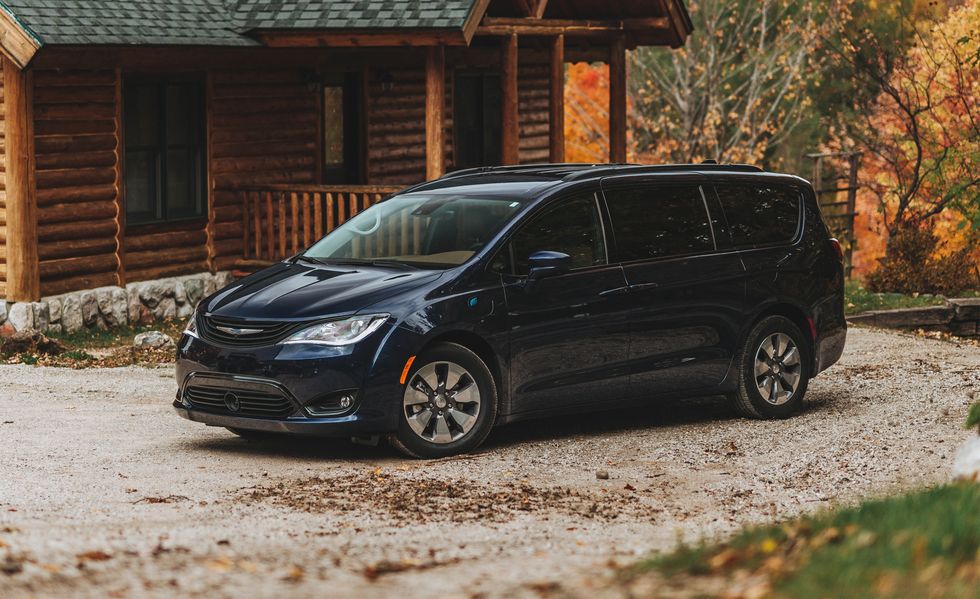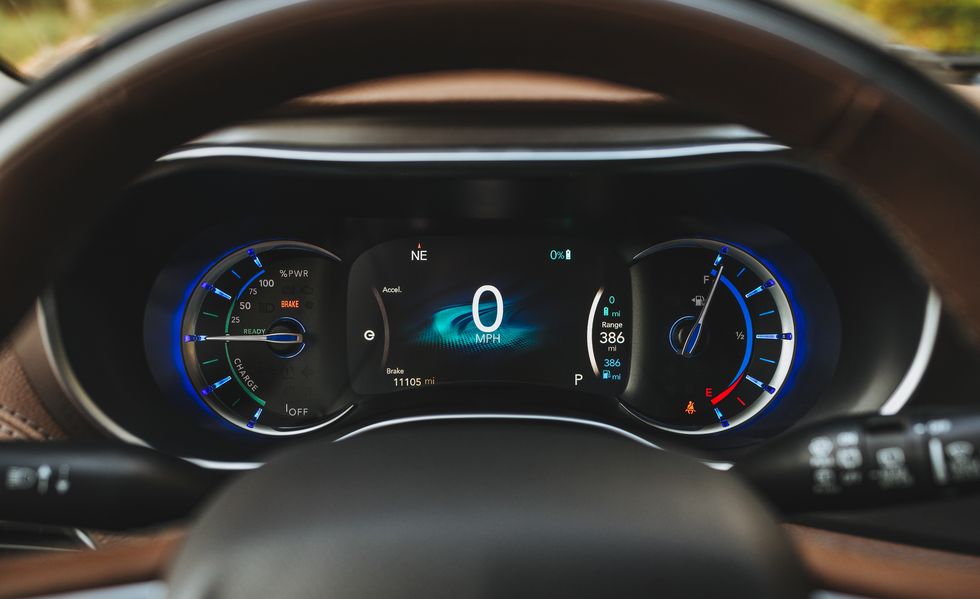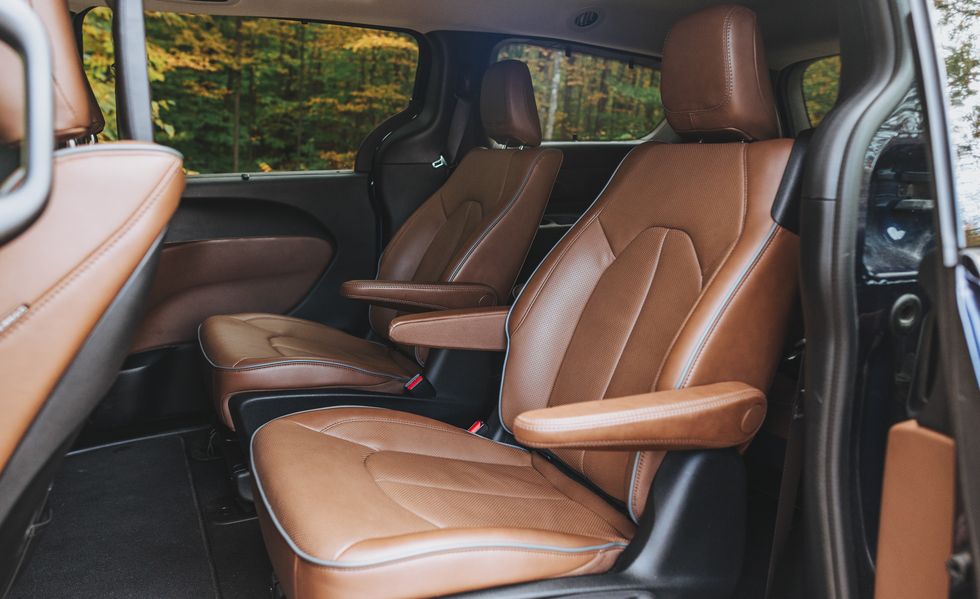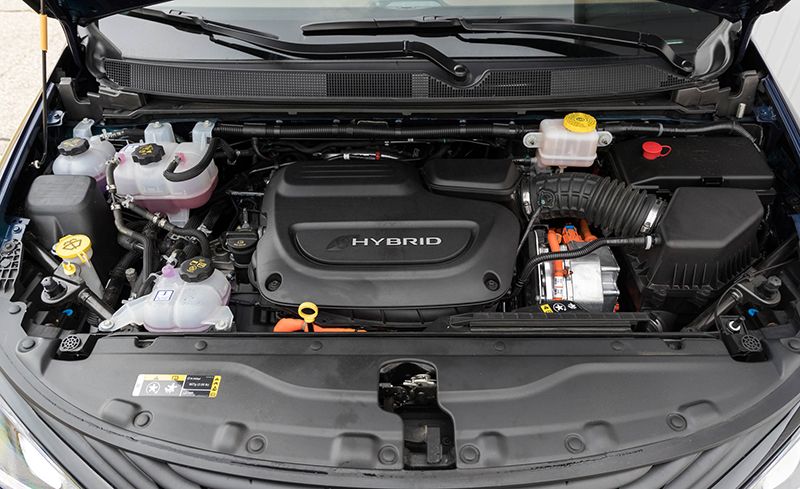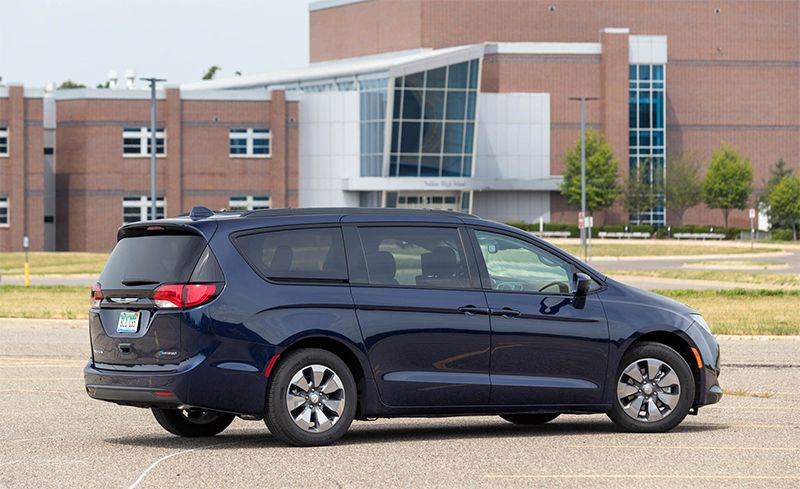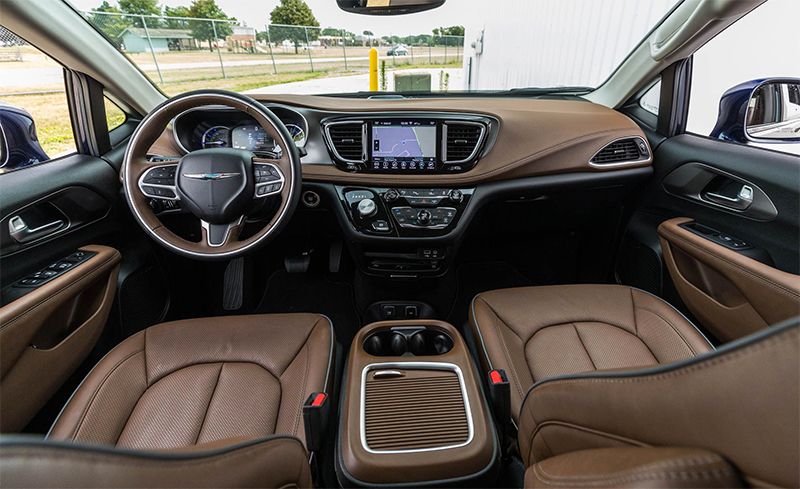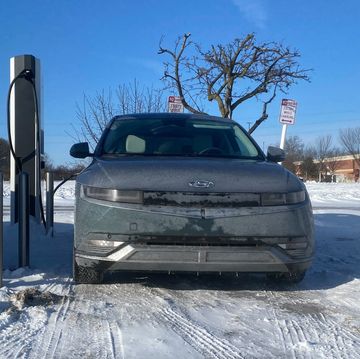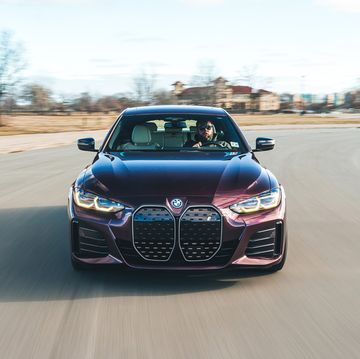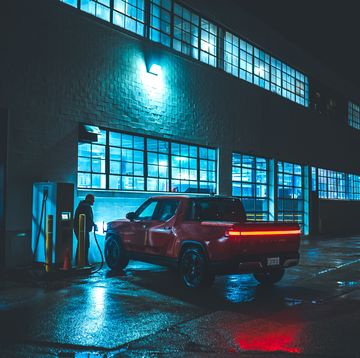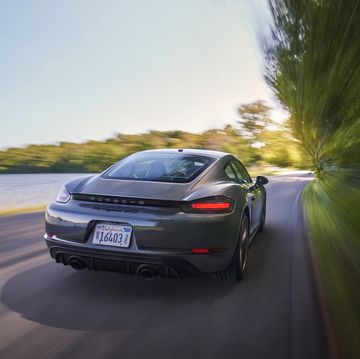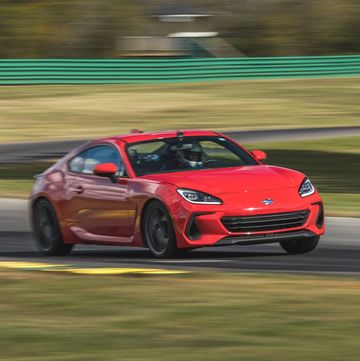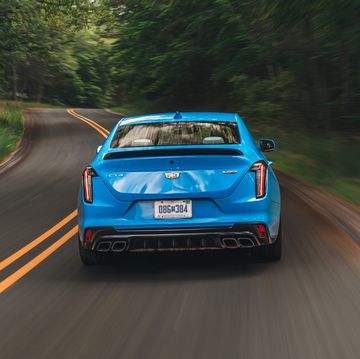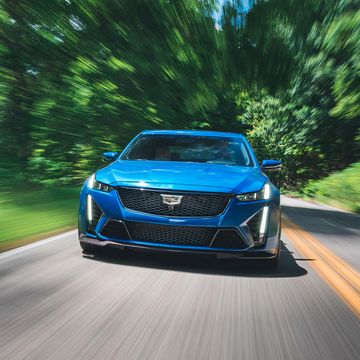40,000-Mile Wrap-Up
Perhaps one day we'll look back on the Chrysler Pacifica hybrid and say it was ahead of its time. After all, it's the first—and currently only—electrified minivan sold in the United States. Furthermore, it's among few plug-in hybrids or EVs that offer three-row seating. With a commodious cabin and better fuel economy than many three-row SUVs, the Chrysler essentially monopolizes the eco-friendly family-transportation niche. Still, now that we've spent one year and just over 40,000 miles evaluating this one-of-a-kind caravan, we can confirm that the Pacifica hybrid is the inferior version of an otherwise outstanding minivan.
The biggest obstacle facing the Pacifica-with-a-plug is that it shares a showroom with the phenomenal nonhybrid Chrysler Pacifica, which has earned three consecutive spots on our 10Best Trucks and SUVs list. None of those awards included the hybrid version, for reasons we'll touch on below. Our Pacifica arrived almost as soon as the gasoline model departed our long-term fleet, leaving a metaphorical sea of praise behind. Whereas the regular Pacifica was innovative and mostly trouble-free during that period, we found the hybrid to be frequently irritating and occasionally problematic.
Extensive Warranty Work and Repeated Infotainment Issues
While our Pacifica hybrid completed the final 10,000 miles without any major expenses, it wasn't completely drama-free. We had to replace both front anti-roll-bar end links under warranty to fix a persistent rattle from the front end. The dealership also had to replace the whole center console, due to a seized cupholder bin on the lower back side that was permanently stuck open. Luckily, this was covered under warranty, or it would've cost us $1590. These recent issues were preceded by regular logbook entries over the first 30,000 miles about disconcerting engine noises (something the dealership said was normal) and an unsettling incident where the hybrid's 16.0-kWh battery pack had to be replaced. Similarly, we experienced two instances where the battery coolant was low, but the dealer was unable to diagnose the cause either time. All of these problems were covered under warranty, which is great, but it certainly made editors think twice about taking what is otherwise a great road-trip car on road trips, not to mention gave us doubts about the minivan's long-term reliability.
However, despite making several more unscheduled visits to the dealer, the electrified Pacifica actually cost us less money to maintain than its standard sibling. Over the course of 12 months, we spent $558 on service for the hybrid, compared with $572 on the nonhybrid. Take that nugget of savings with a grain of salt, since any potential problems with the complex hybrid components will become an out-of-pocket expense once their warranty expires after 10 years or 100,000 miles.
As the digital odometer approached the 40,000-mile finish line, vehicle testing director Dave VanderWerp noted that the Pacifica hybrid felt tired. He had just driven his family more than 1000 miles on a round trip from near Ann Arbor, Michigan, to Washington, D.C., and described a constant and annoying vibration through the steering wheel at highway speeds. While the minivan averaged 30 mpg on that trip (it wasn't plugged in once on the trip, hence "mpg" not "MPGe"), VanderWerp said he had observed better fuel economy with our previous nonhybrid Pacifica. Along with the 8.4-inch Uconnect touchscreen intermittently not responding for the umpteenth time, VanderWerp also reported an occasional problem with the optional rear-seat entertainment system. When he attempted to access the Uconnect Theater through the Media menu on the front touchscreen, it displayed a blank screen. This latest complaint about the normally terrific Uconnect infotainment system joins several others that have riddled the logbook since our Pacifica hybrid arrived.
Some Redeeming Qualities
Although we've criticized the Pacifica hybrid in comparison with its gasoline-drinking counterpart, there's no denying the plug-in's exclusive format. Sure, it skips the best features that are otherwise available on the regular Pacifica (see: ingenious Stow 'n Go seats and priceless built-in vacuum), but the hybrid will satisfy people who prioritize fuel economy. During our time with it, we averaged 29 MPGe. (For those scratching their heads over that tiny e at the end of MPGe, it indicates we've included the electric energy pumped into the battery in our overall calculation.) Most notably, our long-term Pacifica hybrid was considerably more fuel efficient during its stay than our traditional Pacifica, which averaged 22 mpg over 40,000 miles. That result also translates to a significantly longer highway range of 470 miles, versus the nonhybrid's 410 miles. This is despite the fact that the plug-in has a 16.5-gallon fuel tank, compared with the conventional Pacifica's 21-gallon tank.
For those wondering why the average economy we achieved falls so far short of the EPA's 84-MPGe combined estimate, it is because the EPA's highly advertised number is essentially the economy the van gets when the battery is actively depleting its state of charge (essentially, during its 33-mile EPA range). Once the battery is in charge-sustaining mode (acting like a normal hybrid), the EPA estimates the Pacifica hybrid should get 30 mpg combined. In our hands it was usually parked in home garages that lack charging equipment or was driven on long road trips that lacked charging stops (what destination-focused driver wants to wait around to recharge a battery that will be fully depleted before the next freeway exit?). It doesn't help that the Pacifica hybrid doesn't have a devoted EV mode (common on many plug-in-hybrid vehicles) that would force it to run only on electricity until the battery is depleted. Theoretically, this could minimize gasoline use when driving primarily in low-speed situations over short distances around town.
For those seeking a hybrid or EV who also want three adult-friendly rows, there are no affordable alternatives. Take advantage of the government's $7500 EV tax credit, and a brand-new 2019 model can be had for less than $35,000. The only cheaper three-row plug-in hybrid is the Mitsubishi Outlander PHEV, but it's nowhere near as practical, and its rearmost seat is no place for full-size human beings. Since the Pacifica hybrid has zero direct competitors, Chrysler owns the market on alternative-fuel minivans. We only wish the company can improve the plug-in's battery-assisted powertrain by smoothing the gasoline-electric handoff and reducing the engine's uncouth noises. Until this unconventional shuttle becomes more reliable and eradicates the litany of glitches we experienced, the Chrysler Pacifica hybrid seems like a better idea than it is a vehicle.
Months in Fleet: 12 months Current Mileage: 40,525 miles
Average Fuel Economy: 29 MPGe
Fuel Tank Size: 16.5 gal Observed Fuel Range: 470 miles
Service: $558 Normal Wear: $0 Repair: $0
Damage and Destruction: $0
Specifications
Specifications
2018 Chrysler Pacifica Hybrid Limited
VEHICLE TYPE
front-engine, front-wheel-drive, 7-passenger, 4-door van
PRICE AS TESTED
$47,730 (base price: $46,340)
ENGINE TYPE
DOHC 24-valve Atkinson-cycle 3.6-liter V-6, 220 hp, 235 lb-ft; 2 permanent-magnet synchronous AC electric motors, 114 and 84 hp, 231 and 92 lb-ft; combined output, 260 hp; 16.0-kWh lithium-ion battery pack
TRANSMISSION
continuously variable automatic
CHASSIS
Suspension (F/R): struts/multilink
Brakes (F/R): 13.0-in vented disc/13.0-in disc
Tires: Michelin Premier A/S, 235/60R-18 103H M+S
DIMENSIONS
Wheelbase: 121.6 in
Length: 203.8 in
Width: 79.6 in
Height: 70.0 in
Passenger volume: 165 cu ft
Cargo volume: 32 cu ft
Curb weight: 5049 lb
PERFORMANCE (NEW)
Zero to 60 mph: 7.4 sec
Zero to 100 mph: 18.5 sec
Rolling start, 5–60 mph: 7.6 sec
Top gear, 30–50 mph: 3.3 sec
Top gear, 50–70 mph: 4.5 sec
Standing ¼-mile: 15.8 sec @ 92 mph
Top speed (governor limited): 104 mph
Braking, 70–0 mph: 187 ft
Roadholding, 300-ft-dia skidpad: 0.81 g
PERFORMANCE (40,000 MILES)
Zero to 60 mph: 7.5 sec
Zero to 100 mph: 18.7 sec
Rolling start, 5–60 mph: 7.8 sec
Top gear, 30–50 mph: 3.4 sec
Top gear, 50–70 mph: 4.8 sec
Standing ¼-mile: 15.9 sec @ 92 mph
Top speed (governor limited): 107 mph
Braking, 70–0 mph: 178 ft
Roadholding, 300-ft-dia skidpad*: 0.83 g
*stability-control-inhibited
C/D
FUEL ECONOMY
Observed: 29 MPGe
75-mph highway driving, EV/hybrid mode: 63 MPGe/33 mpg
Highway range, EV/hybrid mode: 25/540 mi
Unscheduled oil additions: 0 qt
EPA FUEL ECONOMY
Combined/city/highway: 32/32/33 mpg
Combined gasoline+electricity: 84 MPGe
EV range: 33 miles
WARRANTY
3 years/36,000 miles bumper to bumper;
5 years/60,000 miles powertrain;
10 years/100,000 miles hybrid components;
5 years/unlimited miles corrosion protection;
5 years/60,000 miles roadside assistance
30,000-Mile Update
A minivan, such as our long-term Chrysler Pacifica hybrid, is an undoubtedly practical machine. And with Chrysler's segment-exclusive plug-in setup, the Pacifica is an impressively efficient means of ferrying the stuff of daily suburban life. Yet the entries in our example's logbook continue to do it no favors with their slew of colorful descriptors chiding the van's uncouth hybrid powertrain.
With our impressions still fresh from our previous, nonhybrid long-term Pacifica, the plug-in's unrefined noises and vibrations that filter even through the pedals affirm our assertion that it is a less compelling alternative. The electrified Pacifica also feels more cumbersome to drive, much of which could be attributed to the hybrid's additional 534 pounds of mass. Along with a routine service at about 33,000 miles for an engine-oil and air-filter change ($125), we had the dealer investigate the van's powertrain grumbles, to no avail; despite inspecting and test driving the Pacifica, the service department's verdict was that the noises we're hearing are part of the van's normal operation. Thankfully, our long-termer hasn't had any major issues since a debacle with its battery led to the replacement of the 16.0-kWh lithium-ion pack and the reprogramming of the battery-control unit to correct a charging issue.
However, some drivers have experienced minor electronic issues, such as the van's 8.4-inch touchscreen freezing for a prolonged period. Road-test editor Charlie Dryer noted that the screen froze on the highway, and the system responded only to being turned on and off. Even when he cycled the minivan's ignition after parking it for a spell, the display remained unresponsive. He found a remedy in an online forum that suggested performing a soft reset, a procedure that entails putting the Pacifica's ignition into accessory mode, simultaneously holding down the volume and tuning knobs for 30 seconds, releasing the knobs, turning off the van, opening the driver's door for 30 seconds and then closing it, restarting the vehicle, and then letting the Uconnect infotainment system load. Once Dryer executed that Konami cheat code, everything worked fine.
Despite mounting complaints, the plug-in Pacifica continues to accumulate miles more quickly than most vehicles in our long-term fleet. The majority of that mileage was collected on multiple long-distance journeys, including a roughly 2500-mile round trip from Ann Arbor, Michigan, to Rocky Mountain National Park in northern Colorado. The minivan also took part in a trouble-free adventure to and from Michigan's Upper Peninsula. Throughout its travels, the Pacifica's average fuel economy of 27 MPGe remains quite strong for a 5049-pound van—and 5 mpg better than our conventional Pacifica averaged during its 40,000-mile stay with us.
Months in Fleet: 11 months Current Mileage: 33,125 miles
Average Fuel Economy: 27 MPGe
Fuel-Tank Size: 16.5 gal Observed Fuel Range: 440 miles
Service: $390 Normal Wear: $0 Repair:$0
Damage and Destruction: $0
20,000-Mile Update
We've now racked up more than 20,000 miles on our long-term 2018 Chrysler Pacifica hybrid, and unlike Scotch and cigars, it has not gotten better with age. While the gas-powered Pacifica has earned the title of Best Van for the third consecutive year as part of our 10Best Trucks and SUVs competition, our decision to continually disavow the hybrid version has been further solidified by some of our negative experiences in this long-term test. Sure, Chrysler's minivan is routinely useful and an unquestionably unique plug-in hybrid—it's the only such minivan on the market—but its recent mysterious issues and frustrating compromises continue to validate our decision to exclude it.
WHAT WE LIKE: As the only van in our long-term fleet, which also includes just one pickup truck (a Honda Ridgeline), the Pacifica hybrid continues to be requested regularly for hauling duty and long trips—even if that's more out of necessity rather than desire. Its removable second-row captain's chairs and stowable third-row seats make it an effective way to move bulky stuff, especially things that shouldn't travel unprotected from the elements in the back of a pickup truck. Its cavernous interior can hold up to seven adult passengers in near-perfect comfort for prolonged periods. Its hospitable front seats in particular cosseted our backsides on a recent cross-country trip from Michigan to California that covered nearly 5000 miles; road test editor Charlie Dryer returned home singing the praises of the Pacifica's comfort and versatility. And its handsome cabin features excellent ergonomics as well as countless bins, cubbies, and cupholders that keep the small items in your life at your fingertips.
WHAT WE DON'T LIKE: While the Pacifica hybrid has many of the traits that make minivans great, its plug-in powertrain requires various compromises. Such as our previous lamentations that the hybrid loses the (more versatile than comfortable) Stow 'n Go second-row seats that fold flat into the floor. It's a disadvantage that looms large every time we have to remove the pair of cumbersome captain's chairs from their locking mechanisms. And it's not just an annoyance; the seats weigh a hefty 66 pounds apiece, making it impossible for some owners to remove or install without assistance. "The first time an owner removes the second-row seats, they'll be cursing the lack of Stow 'n Go," said our head of testing, Dave VanderWerp. He was also frustrated with the center child-seat LATCH point on the second-row seats, which is located very far down the seatback, making it difficult to reach from the front.
Nearly every other note in the Pacifica's logbook makes mention of its coarse-sounding engine. While the hybrid model uses a version of the gasoline-powered 3.6-liter V-6 found in the regular Pacifica, it features revised internal components and runs the more efficient Atkinson cycle. Many editors have described unpleasant or thrashy noises when the engine is idling. This has seemed to become worse with the arrival of winter temperatures, especially when the engine is fired via the remote-start system. And associate online editor Joey Capparella called the two-motor transaxle's operation "jarring," particularly when restarting the engine, and noted a variety of unusual sounds and vibrations while driving.
WHAT WENT WRONG: Not long after we experienced serious issues with the Pacifica's hybrid system, which required replacing the entire battery pack under warranty and later updating its software because it wasn't charging, a warning light appeared, along with a "Service Hybrid Electric System" message. We eventually discovered that this was triggered by the coolant-level sensor, and the dealership confirmed that the battery coolant was one pint low. The technician refilled the coolant but was unable to diagnose the issue because no leaks were found. A couple thousand miles later, the warning light went off again, and again the battery coolant was low. The dealership drained and refilled the coolant reservoir but still couldn't find any leaks. While we haven't had any problems with the coolant level since then, the issue remains a mystery.
WHERE WE WENT: Our Jazz Blue minivan has now literally traveled from sea to shining sea. With a trip to the East Coast already under its wheels, it was recently driven across the country to the West Coast. We set sail for Sonoma, California, loaded down with various gear to compete in a LeMons race and carrying artwork to be delivered to the family of the late, great Tony Swan. The ambitious trek included stops in Des Moines, Iowa, and Golden, Colorado, to name a few. Otherwise, our Pacifica hybrid has remained mostly in the Midwest since we cracked 10,000 miles.
Months in Fleet: 7 months Current Mileage: 22,536 miles
Average Fuel Economy: 27 MPGe
Fuel Tank Size: 16.5 gal Observed Fuel Range: 440 miles
Service: $264 Normal Wear: $0 Repair: $0
Damage and Destruction: $0
10,000-Mile Update
Unglamorous though it may be to some, the minivan is one of the most versatile forms of transportation. The Chrysler Pacifica enhances that truth with its stylish exterior, superb interior ergonomics, and innovative features, all of which helped it defeat the new-for-2018 class stalwart Honda Odyssey to be named the best van on our 2018 10Best Trucks and SUVs list. However, we withheld that honor from the Pacifica's plug-in-hybrid variant because of its sometimes unrefined powertrain operation and uneven power delivery. Still, we adopted one into our long-term fleet to better evaluate the electrified van's viability and reliability over 40,000 miles. After its first 10,000 miles, the Pacifica hybrid has yet to make us reconsider.
WHAT WE LIKE: Despite sharing the parking lot with flashy long-termers such as the Infiniti QX50 and the Range Rover Velar, the Pacifica hybrid has been one of the most highly requested vehicles at C/D headquarters. That's because this rolling apartment is perfect for family road trips and can double as a moving truck. While most minivans earn high marks for practicality—and the regular Pacifica aces that test—the hybrid version also is currently the only affordably priced three-row plug-in-hybrid electric vehicle (PHEV) on the market, and it has a useful 30-plus miles of electric-only range.
The hybrid powertrain imbues this Pacifica with epic driving range. Over the course of a long weekend traveling to Big Star Lake in the northwestern part of Michigan's Lower Peninsula, the Pacifica went 565 miles between fill-ups. That distance was bolstered by a couple charges of its 16.0-kWh battery pack, which takes roughly 14 hours when using a 120V outlet or two hours on a 240V Level 2 charger. Still, the van's trip computer reported more than 10 hours of driving on a single tank of gas.
WHAT WE DON'T LIKE: Although the Pacifica hybrid shares many praiseworthy elements with the conventionally powered model, such as its well-executed cabin and expansive forward visibility, it's the missing elements that make this version less compelling. Most notably, the hybrid is not available with the regular Pacifica's signature Stow 'n Go second-row seats. Instead of folding into underfloor bins—which are occupied by a battery pack in the hybrid—its bulkier and heavier second-row seats must be removed and reinstalled to open up the expansive cargo area. On the upside, those seats are way more comfortable for adults than the stowable ones.
We're also irritated that Fiat Chrysler doesn't include a standard spare tire in any Pacifica, but at least the traditional model offers an optional inflatable spare. You can't get it on the hybrid. Likewise missing from the hybrid's option list is the built-in vacuum that's so handy for quick and easy cleanups of the inevitable messes a kid-friendly conveyance is going to suffer.
Unlike most plug-in hybrids, the electrified Pacifica does not have a pure-electric mode; its gasoline engine and dual electric motors regularly engage in an on-again, off-again exchange, and the handoffs aren't always smooth. Technical director Eric Tingwall wrote, "I know there's not much power available from the traction motor, but a plug-in hybrid without an EV mode is an incomplete vehicle." Although it does have a Hybrid mode that increases regenerative-braking force, those levels are insufficient for single-pedal driving.
WHAT WENT WRONG: The Pacifica hybrid rolled in to the dealership for its recommended 10,000-mile service without giving us a hint of trouble. Along with an oil change, tire rotation, and multipoint inspection that cost $101, the dealership performed a recall service to update the powertrain control module, battery-pack control module, and power-inverter module. While we didn't experience any malfunctions, FCA issued the recall to prevent a cruise-control glitch that could potentially cause the system to maintain speed or accelerate unless the driver shifts into neutral or applies the brakes.
Barely 500 miles later, on a trip to Grand Rapids (about 140 miles west of our Ann Arbor office), the minivan rattled on startup and went into limp-home mode. Photo assistant Charley Ladd was behind the wheel and nursed it to the closest dealership, where the technicians determined that the high-voltage battery needed to be replaced (!), a job that was covered under warranty. However, after installation, the battery wouldn't charge. A field engineer was dispatched to diagnose the issue and found that the battery control unit had the wrong software installed. Reprogramming it fixed the charging problem, but the dealer was not able to re-create the rattle on startup.
WHERE WE WENT: The Pacifica hybrid has been plenty busy shuttling our staff, our stuff, and our families around the Midwest. Many weekend jaunts have been made to the northern part of Michigan's mitten peninsula, and the hybrid also spent time in neighboring Ohio and made a trip to Butler, Pennsylvania.
Months in Fleet: 5 months Current Mileage: 11,358 miles
Average Fuel Economy: 29 MPGe
Fuel Tank Size: 16.5 gal Observed Fuel Range: 470 miles
Service: $101 Normal Wear: $0 Repair: $0
Damage and Destruction: $0
Introduction
Barely three months after wrapping up 40,000 virtually trouble-free miles with a Chrysler Pacifica, we signed up for another long-term test of the company's cutting-edge minivan. Except this time our staff is stuffing their baggage and loved ones into the plug-in-hybrid version. While the regular Pacifica was so highly regarded that we named it a 10Best winner two years running, its electrified counterpart didn't make the cut. We cited its coarse and unpredictable gasoline-electric powertrain for that omission. The van also trades Chrysler's trademark Stow 'n Go second-row seats that fold flat into underfloor bins for the obligatory high-voltage battery pack. However, there are few plug-in hybrids on the market with the Pacifica's three-row seating and utility. In fact, the only similar alternative is the Volvo XC90 T8 plug-in hybrid, which is less practical and much more expensive. Therefore we've added the first and only plug-in minivan in America to our long-term fleet to discover whether its exclusive format is worth the investment.
The Pacifica's reverential rise started after Chrysler released the all-new minivan for 2017, replacing its soulless predecessor—the Town & Country. In addition to sleeker exterior styling and extensive contemporary features, it received a completely new platform with an independent rear suspension that improved ride and handling and optimized interior space and packaging. The company also dropped in the latest 3.6-liter Pentastar V-6 paired with a nine-speed automatic transmission and driving the front wheels, the only setup available on nonhybrid models. The plug-in version was available for 2017, and it still represents the brand's lone pluggable offering (the only other example in the Fiat Chrysler Automobiles family is the tiny Fiat 500e). This hybrid also gets a 3.6-liter V-6, but it's modified with different pistons, camshafts, and valves. An increased compression ratio and Atkinson-cycle timing further improve fuel efficiency, although total output drops to 260 horsepower. The hybrid's most significant hardware is its eFlite automatic transmission, which features two electric motors. Whereas some two-motor-hybrid transaxles designate one motor to be the generator and the other to deliver torque to the wheels, FCA's design uses a one-way clutch that allows the generator unit to turn the front wheels, too. This setup saves space and—theoretically—increases efficiency and refinement. The Pacifica's plug-in powertrain includes a 16.0-kWh lithium-ion battery pack that can be fully charged in two hours using a 240-volt outlet or in 14 hours on 120 volts. A 6.6-kW onboard charger is standard. The regenerative-braking system helps recharge the battery during operation, but this hybrid's lack of variable regen settings renders single-pedal driving odd and disappointing. Technically, there's no all-electric mode, which makes keeping the van from burning gasoline a delicate game between foot and pedal. Selecting the L position with the rotary shift knob adds a subtle dose of regen resistance when the driver lifts off the accelerator pedal but not nearly to the degree offered by most other electrified vehicles.
Is the Hybrid's Literal Juice Worth the Proverbial Squeeze
How efficient is the Pacifica hybrid? Well, the EPA rates the Pacifica at 84 MPGe combined, which exceeds the XC90 but falls short of premier plug-in options. Still, most prospective buyers will compare the Pacifica with other minivans. Here, the hybrid's fuel-economy advantage hinges on whether long road trips are common or sporadic. Our real-world testing revealed the hybrid Pacifica was a little thriftier on the highway, returning 33 mpg versus the nonhybrid's 31. However, the electrified version operates best in the city, where it can utilize regenerative braking and the low-end torque of the traction motor—and theoretically duplicate the EPA's estimate of 32 mpg (versus 19 mpg on nonhybrids). After nearly 7000 miles with the hybrid, we're getting 28 MPGe. While these were mostly highway miles, compare that with the 22 mpg we observed after our long-term test of the nonhybrid Pacifica. These differences will ultimately determine whether the standard or hybridized Pacifica is the better value. While you can have a gas-powered Pacifica for as little as $28,390, the cheapest hybrid version costs $41,390 (before the available $7500 tax credit).
Regardless of powertrain configuration, both versions of Chrysler's minivan are loaded with standard features and impressive options. Aside from the aforementioned Stow 'n Go omission, the Pacifica hybrid is essentially available with all the same equipment as the nonhybrid. For 2018, Chrysler renamed the hybrid trims to better align with the gasoline models. Thus, Premium becomes Touring L and Platinum becomes Limited; Touring Plus joins the lineup, too. All hybrids have proximity entry, three-zone automatic climate control, and the ultra-user-friendly 8.4-inch Uconnect touchscreen with Apple CarPlay and Android Auto. Specific hybrid pages within Uconnect display monitor energy usage and adjust the charging schedule, among other things. This information and more also can be accessed remotely via smartphone using the Uconnect Access app. Unfortunately, only nonhybrid Pacificas are available with a built-in vacuum cleaner. Pity, because we've already been exposed to the minivan's propensity for crumb and hair collection. Still, every Pacifica has standard blind-spot monitoring, rear cross-traffic alert, and rear parking sensors with rear automated emergency braking.
Putting Together Our Ideal Hybrid Family Hauler
To experience all the Pacifica hybrid has to offer, we chose the top-of-the-line Limited version because of its exclusive features. Before the available $7500 federal tax credit, it starts at $46,340, a $5000 premium over the lowest-spec Touring Plus. Every Limited has premium leather upholstery, heated and cooled front seats, and hands-free power side doors and liftgate. Other Limited exclusives include a standard 20-speaker Harman/Kardon stereo and Uconnect Theater system, with two 10-inch touchscreens that fold up from the back of the front seats. Along with wireless streaming for Android-only devices and/or a Blu-ray player, the dual screens boast built-in apps that will pacify little tots and even teens with a variety of games and such. From the options list, we selected the Advanced SafetyTec package because it has robust content available only on the Limited. For $995, it includes a 360-degree camera, forward-collision warning, automated emergency braking, lane-keeping assist, and more. We also opted for the $395 Hybrid Special Appearance package, which replaces all the chrome exterior trim with black accents and upgrades the standard 17-inch wheels to 18-inch rollers wrapped with Michelin Premier A/S rubber. We also selected Jazz Blue Pearl Coat paint to complement our favorite interior color, the tasteful Deep Mocha. All told, our long-term test vehicle totaled $47,730.
Our initial track testing illustrates the performance differences between the Pacifica hybrid and nonhybrid as well as the toll that 40,000 miles can take. Our hybrid test vehicle tipped the scales at 5049 pounds, 534 more than our recently retired gas-only model. Both wore the same 18-inch wheels and Michelin tires, but the heavier hybrid needed 187 feet to stop from 70 mph, or 23 feet longer than the nonhybrid, and it also exhibited slight fade. Likewise, the Pacifica hybrid has less grip, posting 0.81 g on the skidpad versus 0.87 g—added mass never helps. Otherwise, the hybrid had equally impressive acceleration times that were similar to those of the nonhybrid. The electrified version went from zero to 60 mph in 7.4 seconds. And it shamed the regular powertrain in our 50-to-70-mph test that replicates a back-road pass, executing the maneuver 1.5 ticks quicker at 4.5 seconds.
Racking Up the Miles (and the Crumbs) Quickly
Considering we've racked up nearly 7000 miles after barely two months with the Pacifica hybrid, our long-term test may not take so long. While some regard any minivan as stodgy, the Pacifica is a hot commodity among our staff of family travelers and youthful vagrants. It's often booked for trips weeks in advance, and it's commonly swapped during weekdays for moving duties and the like. So far, most journeys have stayed within the Midwest, but assistant technical editor Dave Beard accumulated roughly 1700 miles on a vacation to Cape Cod. He called it an excellent road-trip vehicle that kept its passengers content mile after mile while the minivan was stuffed to the headliner with two bicycles, miscellaneous luggage, and stray family members. Despite traveling at some fast speeds, Beard came away impressed with the van's indicated fuel economy in the high-20-mpg range. However, his clan had issues with the rear-seat entertainment system. The main menus sometimes didn't navigate, and there were problems getting DVDs to play. The unavailable vacuum cleaner was missed after a snack explosion left the black carpeting a mess. Still, Beard and online editor Andrew Wendler agreed that the Pacifica's adaptive cruise control is fluid and doesn't slam into a radar wall the way some systems do.
As deputy online editor Dave VanderWerp observed, "Overall, the Pacifica hybrid is a very interesting option in the plug-in landscape, offering minivan practicality with battery capacity for above-average EV range." But while we recognize the niche that Chrysler has carved out here, we're not yet convinced that its innovative powertrain supersedes the standard model's refinement and overall value. Fortunately, we still have thousands of miles in which to make that determination.
Months in Fleet: 2 months Current Mileage: 6849 miles
Average Fuel Economy: 28 MPGe
Fuel Tank Size: 16.5 gal Observed Fuel Range: 462 miles
Service: $0 Normal Wear: $0 Repair: $0
Specifications
Specifications
2018 Chrysler Pacifica Hybrid Limited
VEHICLE TYPE
front-engine, front-wheel-drive, 7-passenger, 4-door van
PRICE AS TESTED
$47,730 (base price: $46,340)
ENGINE TYPE
DOHC 24-valve Atkinson-cycle 3.6-liter V-6, 220 hp, 235 lb-ft; 2 permanent-magnet synchronous AC electric motors, 114 and 84 hp, 231 and 92 lb-ft; combined output, 260 hp; 16.0-kWh lithium-ion battery pack
TRANSMISSION
continuously variable automatic
CHASSIS
Suspension (F/R): struts/multilink
Brakes (F/R): 13.0-in vented disc/13.0-in disc
Tires: Michelin Premier A/S, 235/60R-18 103H M+S
DIMENSIONS
Wheelbase: 121.6 in
Length: 203.8 in
Width: 79.6 in
Height: 70.0 in
Passenger volume: 165 cu ft
Cargo volume: 32 cu ft
Curb weight: 5049 lb
PERFORMANCE (NEW)
Zero to 60 mph: 7.4 sec
Zero to 100 mph: 18.5 sec
Rolling start, 5–60 mph: 7.6 sec
Top gear, 30–50 mph: 3.3 sec
Top gear, 50–70 mph: 4.5 sec
Standing ¼-mile: 15.8 sec @ 92 mph
Top speed (governor limited): 104 mph
Braking, 70–0 mph: 187 ft
Roadholding, 300-ft-dia skidpad: 0.81 g
PERFORMANCE (40,000 MILES)
Zero to 60 mph: 7.5 sec
Zero to 100 mph: 18.7 sec
Rolling start, 5–60 mph: 7.8 sec
Top gear, 30–50 mph: 3.4 sec
Top gear, 50–70 mph: 4.8 sec
Standing ¼-mile: 15.9 sec @ 92 mph
Top speed (governor limited): 107 mph
Braking, 70–0 mph: 178 ft
Roadholding, 300-ft-dia skidpad*: 0.83 g
*stability-control-inhibited
C/D
FUEL ECONOMY
Observed: 29 MPGe
75-mph highway driving, EV/hybrid mode: 63 MPGe/33 mpg
Highway range, EV/hybrid mode: 25/540 mi
Unscheduled oil additions: 0 qt
EPA FUEL ECONOMY
Combined/city/highway: 32/32/33 mpg
Combined gasoline+electricity: 84 MPGe
EV range: 33 miles
WARRANTY
3 years/36,000 miles bumper to bumper;
5 years/60,000 miles powertrain;
10 years/100,000 miles hybrid components;
5 years/unlimited miles corrosion protection;
5 years/60,000 miles roadside assistance
Eric Stafford’s automobile addiction began before he could walk, and it has fueled his passion to write news, reviews, and more for Car and Driver since 2016. His aspiration growing up was to become a millionaire with a Jay Leno–like car collection. Apparently, getting rich is harder than social-media influencers make it seem, so he avoided financial success entirely to become an automotive journalist and drive new cars for a living. After earning a journalism degree at Central Michigan University and working at a daily newspaper, the years of basically burning money on failed project cars and lemon-flavored jalopies finally paid off when Car and Driver hired him. His garage currently includes a 2010 Acura RDX, a manual '97 Chevy Camaro Z/28, and a '90 Honda CRX Si.
